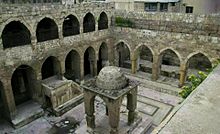Central Synagogue of Aleppo
This article includes a list of general references, but it lacks sufficient corresponding inline citations. (June 2017) |
| Central Synagogue of Aleppo | |
|---|---|
Byzantine | |
| Completed | as early as the 9th century |
The Central Synagogue of Aleppo, (

Brief history
According to tradition, the foundation for the Great Synagogue in Aleppo was constructed by
I went to see the synagogue of the Jews at Aleppo, famed for fairness and antiquity. Their street is entered into by a narrow gate, which is so much lower than the rest, that it is descended to by a considerable number of steps. After I had gone through many of their narrow lanes, which they contrive so, purposely to hide the goodness of the building from the Turks, I came at length to the synagogue; which is a good large square uncovered court, with covered walks or cloysters round about, upheld by double pillars disposed according to good architecture. On the right hand of the entrance, is a kind of great hall, which they make use of for their service in the winter when it is cold or rains; as they do of the court in summer and fair weather: In the middle of the court four pillasters support a cupoletta, under which in a high and decent place, like our altar; lies the volume of the Law, and there also their doctor and principal rabbi stands reading in a kind of musical tone, to whom all the people alternately answer:...
Another account by Elkan Nathan Adler in his book Jews in Many Lands published in 1905 records:
The chief synagogue is very ancient and has many peculiarities. There are several modern additions to it, but the main structure is dated by the Abbe Chagnot as early as the fourth century. It has several inscriptions, some carved on its walls, others painted on them. One is as late as 1861, another as early as 834. The latter is on a chapel stated to have been erected by Mar Ali ben Nathan b. Mebasser b. HaAram....Hebrew inscription... Only four letters are starred, so that the date is probably 1145, sel.=834. The local Jews, however, assume that all the letters count in the perat, but that no thousand is omitted, so that the date would be 654 sel., i.e., 345 of the common era! The letters are certainly archaic, so early an inscription should not be accepted as such without further evidence. There are several chapels surrounding the main building, evidently added from time to time, as the community grew. In each of these
yeshivah and in a secret chamber in the eaves of the roof of one of the side chapels is the genizah.
It had later on undergone a series of modifications until its destruction during the
Occasionally, when possible, trips are made to visit the synagogue by Syrian Jews. An example of such a trip took place on 1 June 2008, when a minyan for the morning services with the Kaddish and Kohanim was conducted by the visitors and former members of the synagogue.[citation needed]
Architecture and layout


The older portions of the synagogue were built in the Byzantine period, perhaps as early as the 9th century. Damaged in the Mongol sack of Aleppo in 1400, the building underwent extensive changes in 1405–1418. With the arrival of the
The
The synagogue edifice was divided into three main sections: a central courtyard that separated the western wing, where in modern times the musta'arabi community used to worship, from the eastern section built at a later time during the 16th century and which served as Beth Midrash and prayer hall of the "Francos", i.e. Sephardi Jews that settled in the town after the Spanish exile and other European Jews that happened to sojourn in Aleppo. An additional enclosed small courtyard was bordering the eastern wing farther to the east.
The western hall had three heichaloth (Holy Arks); there were another three heichaloth on the southern wall ("the Zion Wall") of the courtyard, and a seventh Holy Ark, located in the eastern wing close to the courtyard, also on the southern wall pointing to the direction of
See also
References
- Adler, Nathan. The Jews of Many Lands, Jewish Publication Society; Philadelphia, 1905.
- Zenner, Walter. A Global Community: The Jews from Aleppo, Syria, Wayne State University Press, page 35-39.
